Leadership Styles in Organisations: BPP University MSc LBO Report
VerifiedAdded on 2022/08/29
|22
|4979
|165
Report
AI Summary
This report provides an analysis of various leadership styles, focusing on their application in achieving organizational goals. It includes an evaluation of the servant leadership style, particularly in the context of Starbucks. The report addresses key aspects of leadership, such as defining leadership qualities, understanding different leadership theories, and assessing the impact of leadership on organizational mission and vision. It also explores motivational theories, change management, and self-assessment of leadership potential, strengths, and challenges. The discussion extends to the volatile business environment and the effectiveness of servant leadership, highlighting its benefits and challenges with examples like Nordstrom. This comprehensive analysis aims to provide insights for aspiring leaders to develop their leadership skills and strategies.
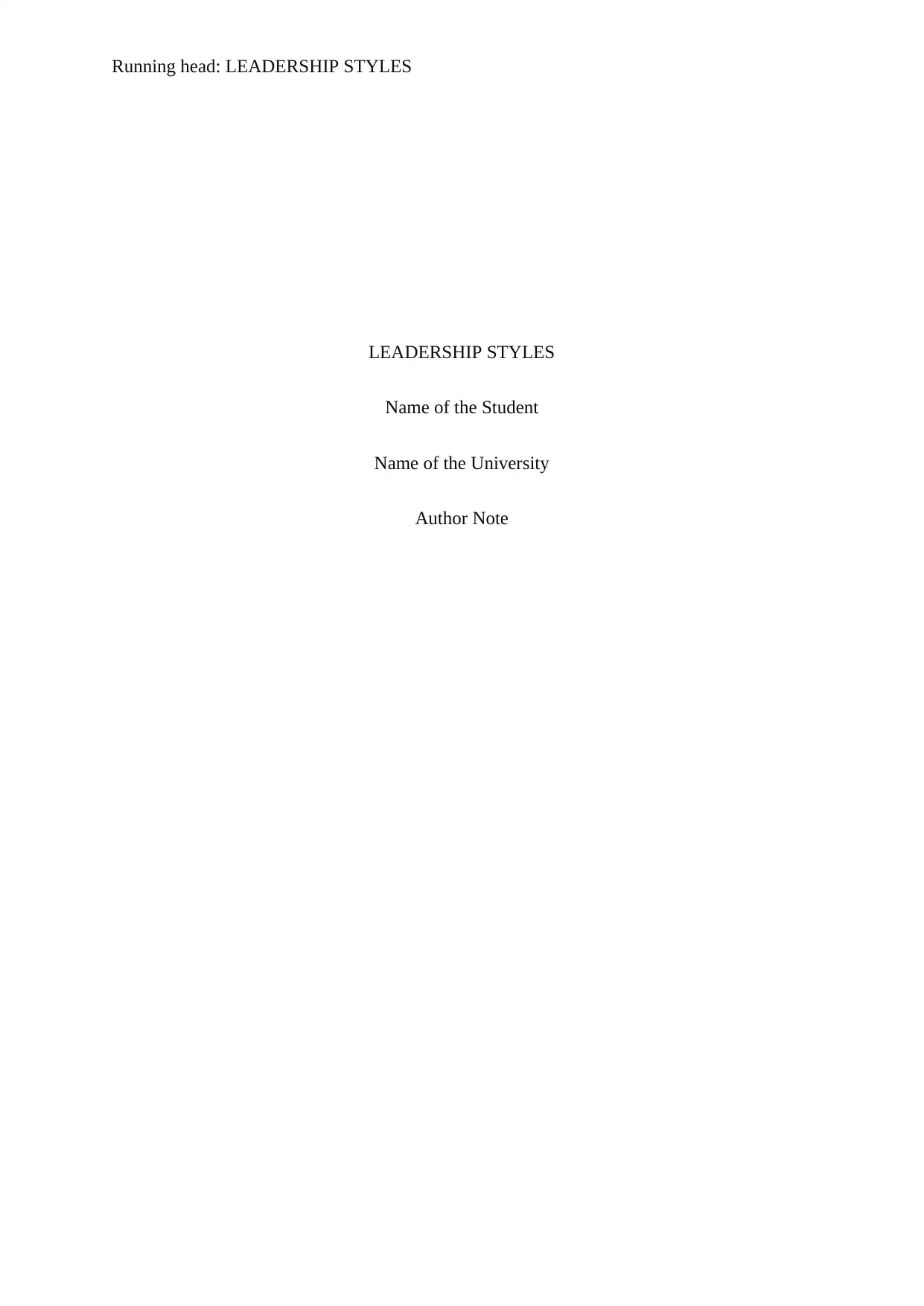
Running head: LEADERSHIP STYLES
LEADERSHIP STYLES
Name of the Student
Name of the University
Author Note
LEADERSHIP STYLES
Name of the Student
Name of the University
Author Note
Paraphrase This Document
Need a fresh take? Get an instant paraphrase of this document with our AI Paraphraser
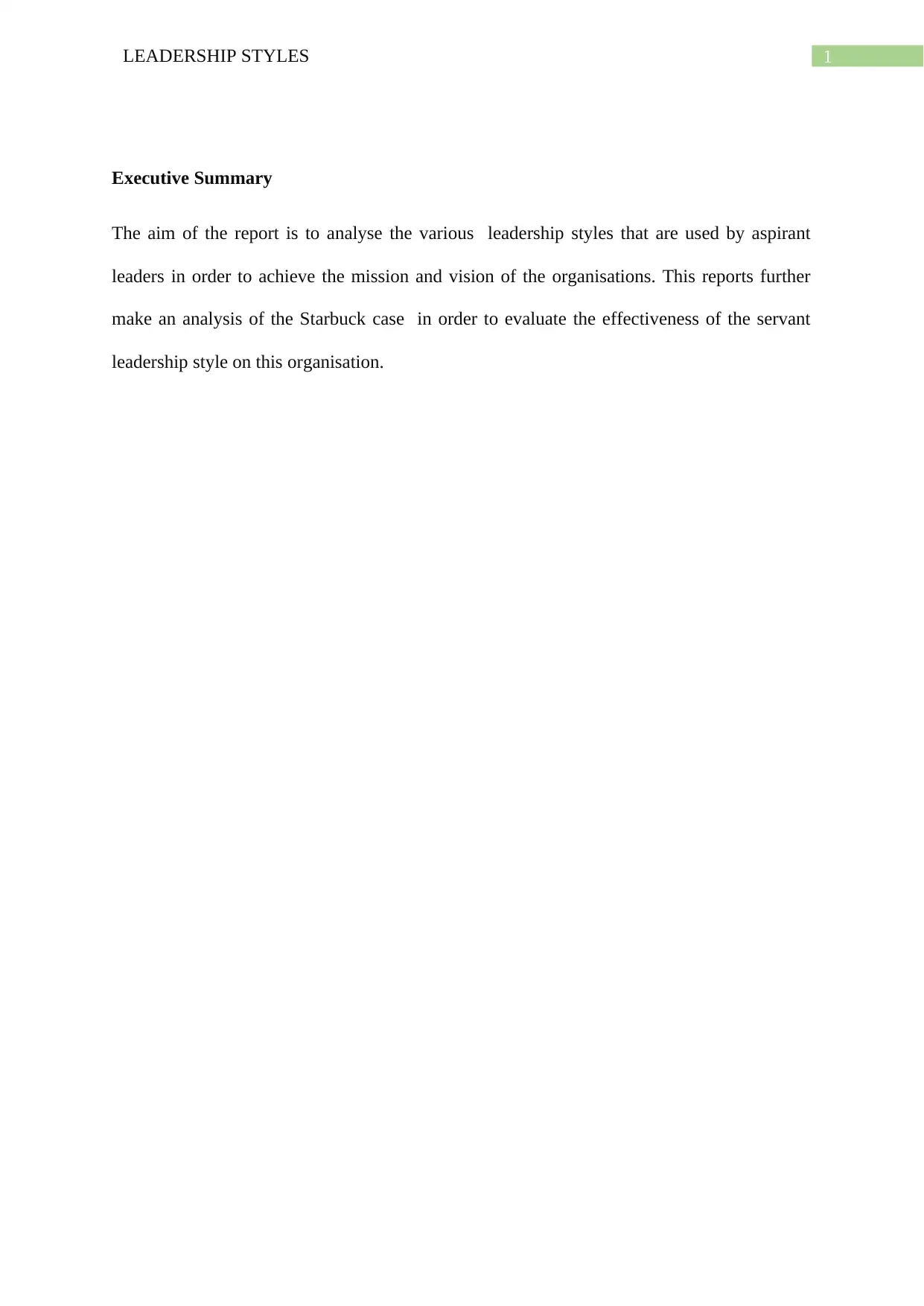
1LEADERSHIP STYLES
Executive Summary
The aim of the report is to analyse the various leadership styles that are used by aspirant
leaders in order to achieve the mission and vision of the organisations. This reports further
make an analysis of the Starbuck case in order to evaluate the effectiveness of the servant
leadership style on this organisation.
Executive Summary
The aim of the report is to analyse the various leadership styles that are used by aspirant
leaders in order to achieve the mission and vision of the organisations. This reports further
make an analysis of the Starbuck case in order to evaluate the effectiveness of the servant
leadership style on this organisation.
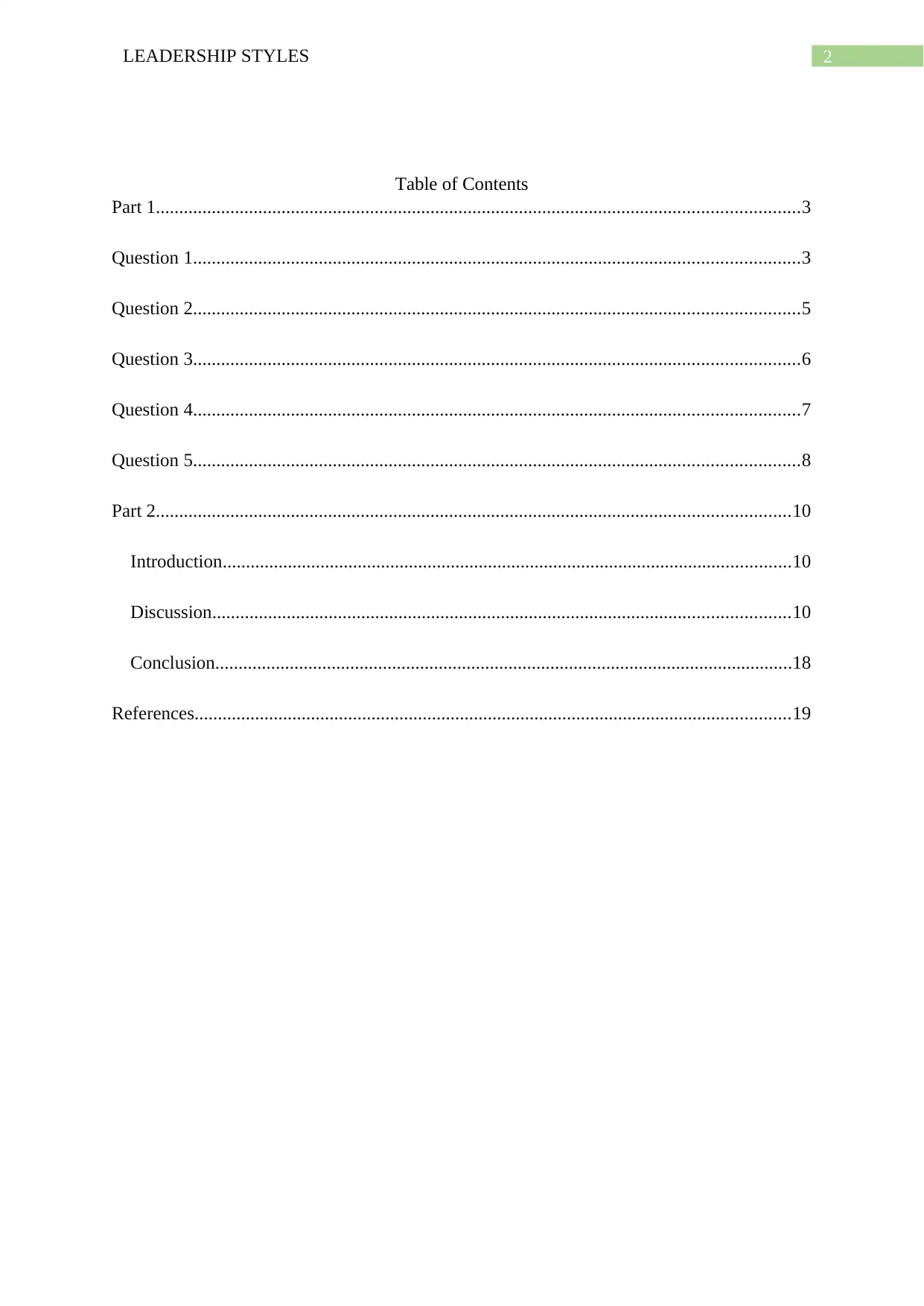
2LEADERSHIP STYLES
Table of Contents
Part 1..........................................................................................................................................3
Question 1..................................................................................................................................3
Question 2..................................................................................................................................5
Question 3..................................................................................................................................6
Question 4..................................................................................................................................7
Question 5..................................................................................................................................8
Part 2........................................................................................................................................10
Introduction..........................................................................................................................10
Discussion............................................................................................................................10
Conclusion............................................................................................................................18
References................................................................................................................................19
Table of Contents
Part 1..........................................................................................................................................3
Question 1..................................................................................................................................3
Question 2..................................................................................................................................5
Question 3..................................................................................................................................6
Question 4..................................................................................................................................7
Question 5..................................................................................................................................8
Part 2........................................................................................................................................10
Introduction..........................................................................................................................10
Discussion............................................................................................................................10
Conclusion............................................................................................................................18
References................................................................................................................................19
⊘ This is a preview!⊘
Do you want full access?
Subscribe today to unlock all pages.

Trusted by 1+ million students worldwide
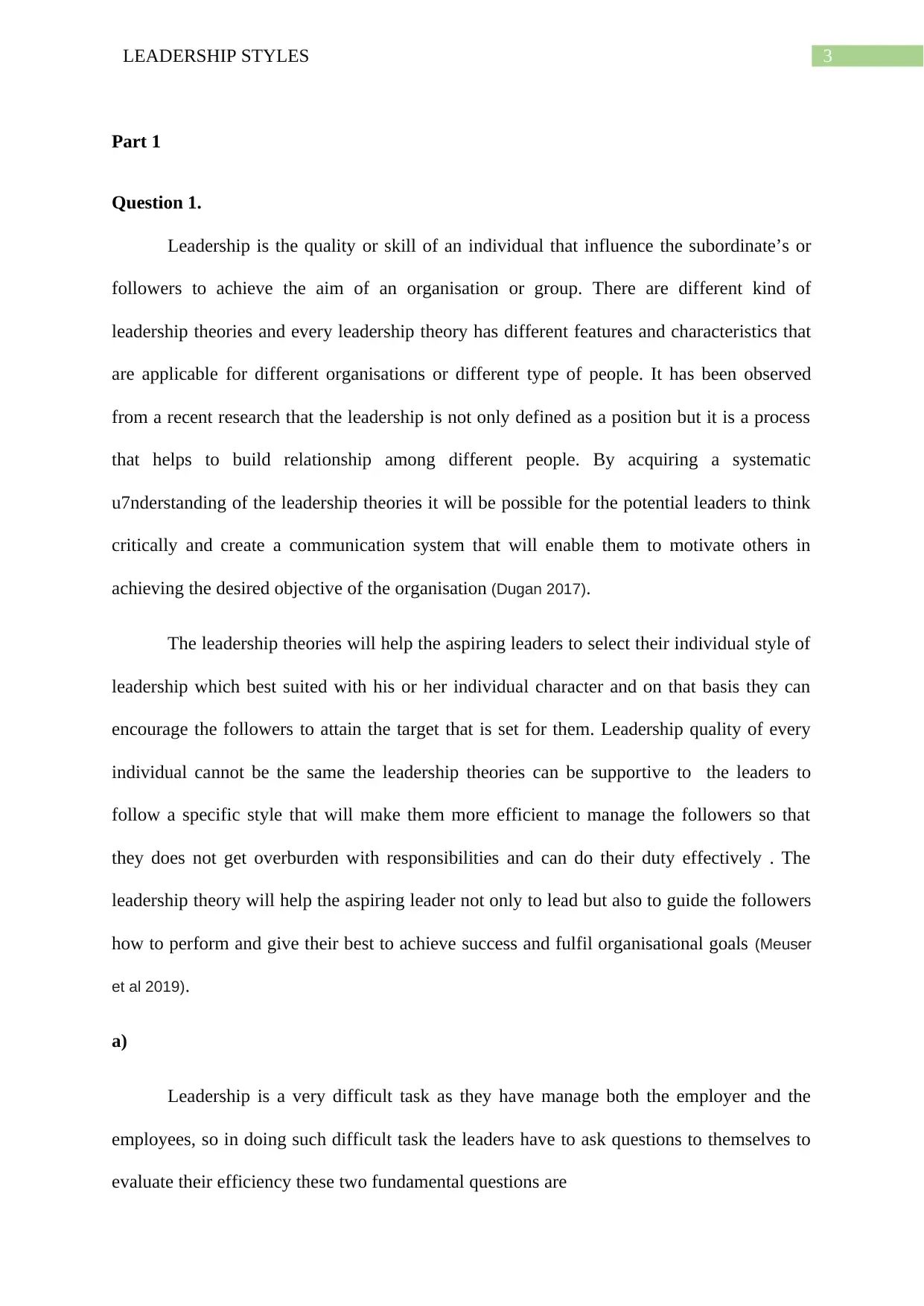
3LEADERSHIP STYLES
Part 1
Question 1.
Leadership is the quality or skill of an individual that influence the subordinate’s or
followers to achieve the aim of an organisation or group. There are different kind of
leadership theories and every leadership theory has different features and characteristics that
are applicable for different organisations or different type of people. It has been observed
from a recent research that the leadership is not only defined as a position but it is a process
that helps to build relationship among different people. By acquiring a systematic
u7nderstanding of the leadership theories it will be possible for the potential leaders to think
critically and create a communication system that will enable them to motivate others in
achieving the desired objective of the organisation (Dugan 2017).
The leadership theories will help the aspiring leaders to select their individual style of
leadership which best suited with his or her individual character and on that basis they can
encourage the followers to attain the target that is set for them. Leadership quality of every
individual cannot be the same the leadership theories can be supportive to the leaders to
follow a specific style that will make them more efficient to manage the followers so that
they does not get overburden with responsibilities and can do their duty effectively . The
leadership theory will help the aspiring leader not only to lead but also to guide the followers
how to perform and give their best to achieve success and fulfil organisational goals (Meuser
et al 2019).
a)
Leadership is a very difficult task as they have manage both the employer and the
employees, so in doing such difficult task the leaders have to ask questions to themselves to
evaluate their efficiency these two fundamental questions are
Part 1
Question 1.
Leadership is the quality or skill of an individual that influence the subordinate’s or
followers to achieve the aim of an organisation or group. There are different kind of
leadership theories and every leadership theory has different features and characteristics that
are applicable for different organisations or different type of people. It has been observed
from a recent research that the leadership is not only defined as a position but it is a process
that helps to build relationship among different people. By acquiring a systematic
u7nderstanding of the leadership theories it will be possible for the potential leaders to think
critically and create a communication system that will enable them to motivate others in
achieving the desired objective of the organisation (Dugan 2017).
The leadership theories will help the aspiring leaders to select their individual style of
leadership which best suited with his or her individual character and on that basis they can
encourage the followers to attain the target that is set for them. Leadership quality of every
individual cannot be the same the leadership theories can be supportive to the leaders to
follow a specific style that will make them more efficient to manage the followers so that
they does not get overburden with responsibilities and can do their duty effectively . The
leadership theory will help the aspiring leader not only to lead but also to guide the followers
how to perform and give their best to achieve success and fulfil organisational goals (Meuser
et al 2019).
a)
Leadership is a very difficult task as they have manage both the employer and the
employees, so in doing such difficult task the leaders have to ask questions to themselves to
evaluate their efficiency these two fundamental questions are
Paraphrase This Document
Need a fresh take? Get an instant paraphrase of this document with our AI Paraphraser
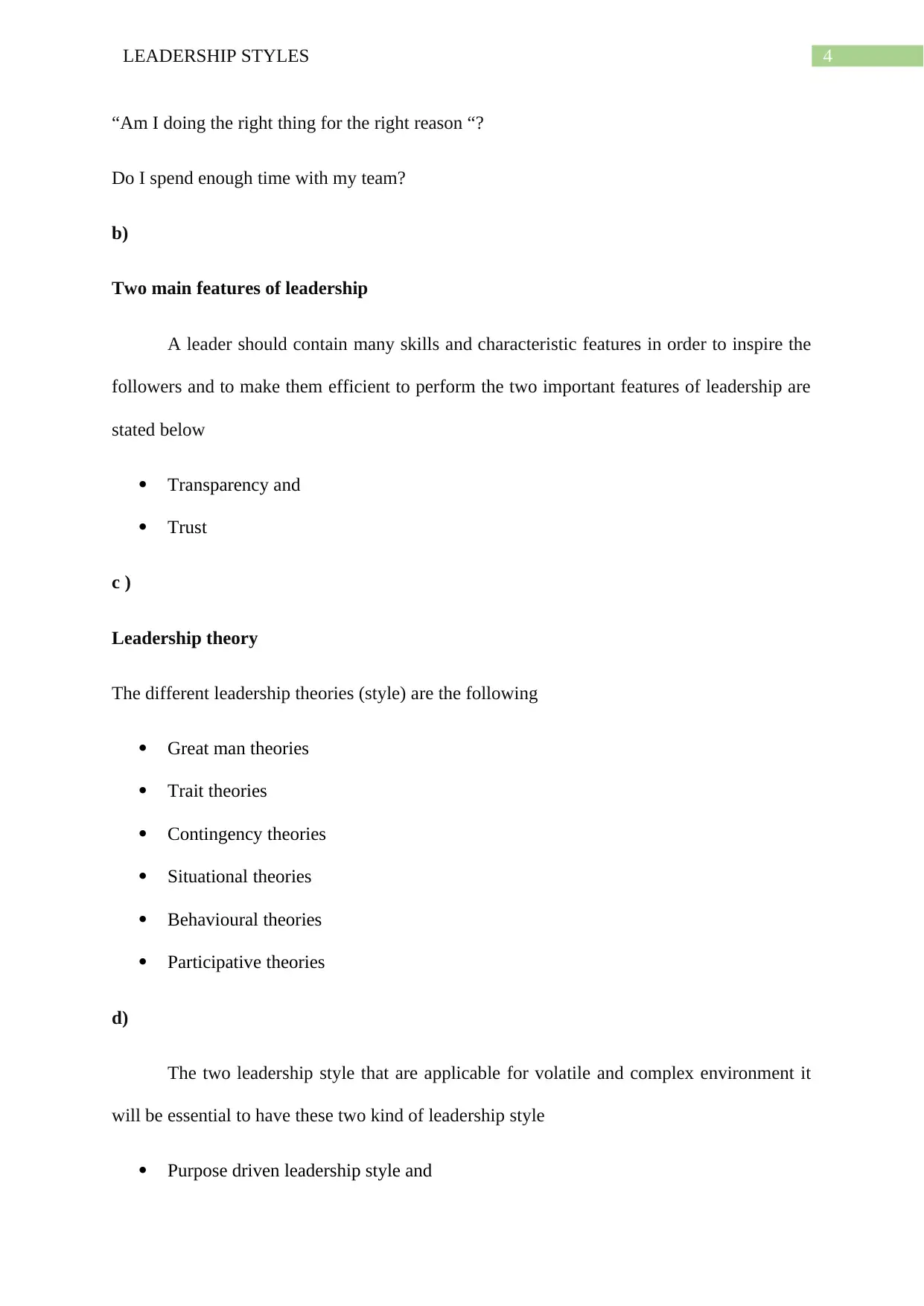
4LEADERSHIP STYLES
“Am I doing the right thing for the right reason “?
Do I spend enough time with my team?
b)
Two main features of leadership
A leader should contain many skills and characteristic features in order to inspire the
followers and to make them efficient to perform the two important features of leadership are
stated below
Transparency and
Trust
c )
Leadership theory
The different leadership theories (style) are the following
Great man theories
Trait theories
Contingency theories
Situational theories
Behavioural theories
Participative theories
d)
The two leadership style that are applicable for volatile and complex environment it
will be essential to have these two kind of leadership style
Purpose driven leadership style and
“Am I doing the right thing for the right reason “?
Do I spend enough time with my team?
b)
Two main features of leadership
A leader should contain many skills and characteristic features in order to inspire the
followers and to make them efficient to perform the two important features of leadership are
stated below
Transparency and
Trust
c )
Leadership theory
The different leadership theories (style) are the following
Great man theories
Trait theories
Contingency theories
Situational theories
Behavioural theories
Participative theories
d)
The two leadership style that are applicable for volatile and complex environment it
will be essential to have these two kind of leadership style
Purpose driven leadership style and
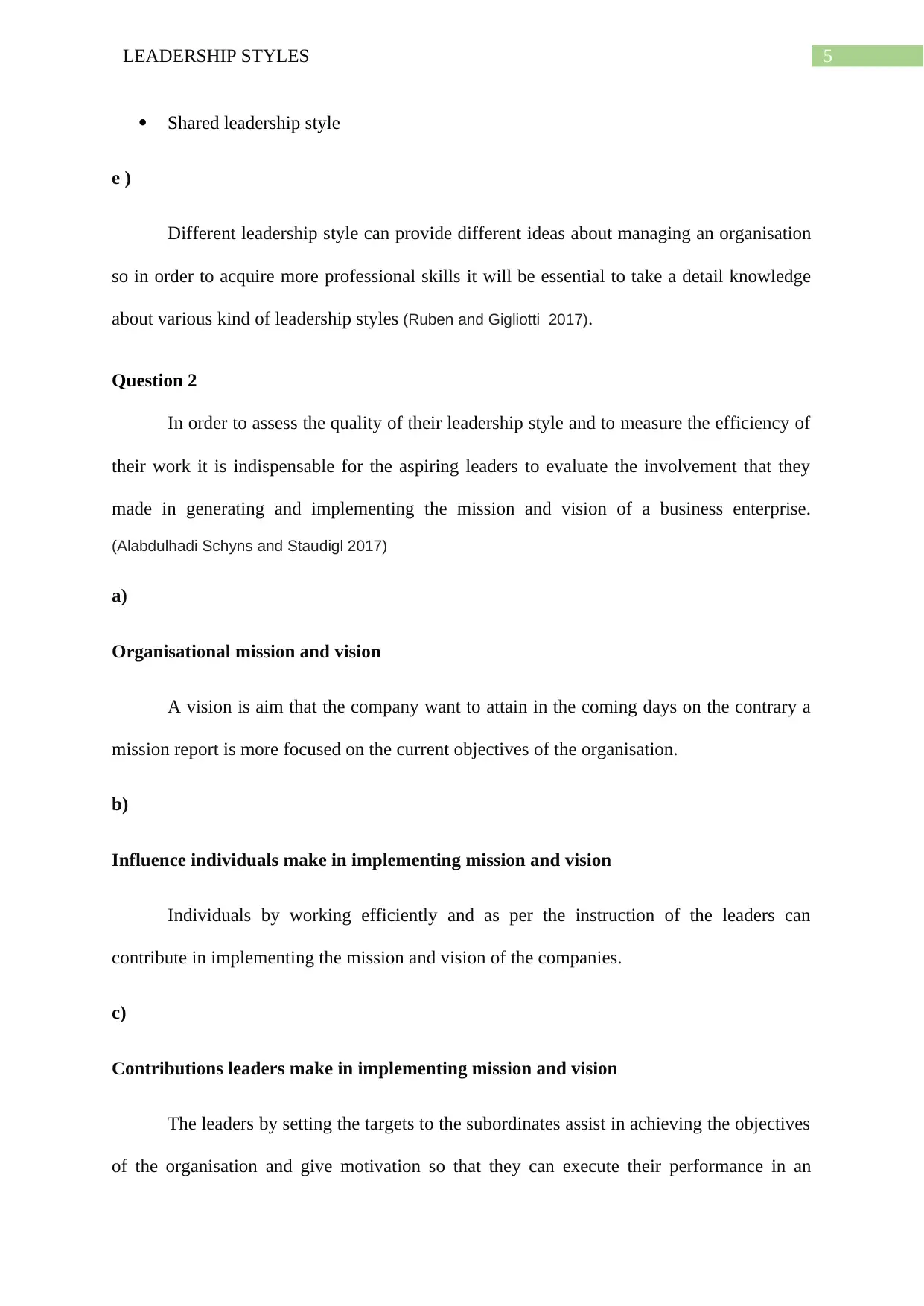
5LEADERSHIP STYLES
Shared leadership style
e )
Different leadership style can provide different ideas about managing an organisation
so in order to acquire more professional skills it will be essential to take a detail knowledge
about various kind of leadership styles (Ruben and Gigliotti 2017).
Question 2
In order to assess the quality of their leadership style and to measure the efficiency of
their work it is indispensable for the aspiring leaders to evaluate the involvement that they
made in generating and implementing the mission and vision of a business enterprise.
(Alabdulhadi Schyns and Staudigl 2017)
a)
Organisational mission and vision
A vision is aim that the company want to attain in the coming days on the contrary a
mission report is more focused on the current objectives of the organisation.
b)
Influence individuals make in implementing mission and vision
Individuals by working efficiently and as per the instruction of the leaders can
contribute in implementing the mission and vision of the companies.
c)
Contributions leaders make in implementing mission and vision
The leaders by setting the targets to the subordinates assist in achieving the objectives
of the organisation and give motivation so that they can execute their performance in an
Shared leadership style
e )
Different leadership style can provide different ideas about managing an organisation
so in order to acquire more professional skills it will be essential to take a detail knowledge
about various kind of leadership styles (Ruben and Gigliotti 2017).
Question 2
In order to assess the quality of their leadership style and to measure the efficiency of
their work it is indispensable for the aspiring leaders to evaluate the involvement that they
made in generating and implementing the mission and vision of a business enterprise.
(Alabdulhadi Schyns and Staudigl 2017)
a)
Organisational mission and vision
A vision is aim that the company want to attain in the coming days on the contrary a
mission report is more focused on the current objectives of the organisation.
b)
Influence individuals make in implementing mission and vision
Individuals by working efficiently and as per the instruction of the leaders can
contribute in implementing the mission and vision of the companies.
c)
Contributions leaders make in implementing mission and vision
The leaders by setting the targets to the subordinates assist in achieving the objectives
of the organisation and give motivation so that they can execute their performance in an
⊘ This is a preview!⊘
Do you want full access?
Subscribe today to unlock all pages.

Trusted by 1+ million students worldwide
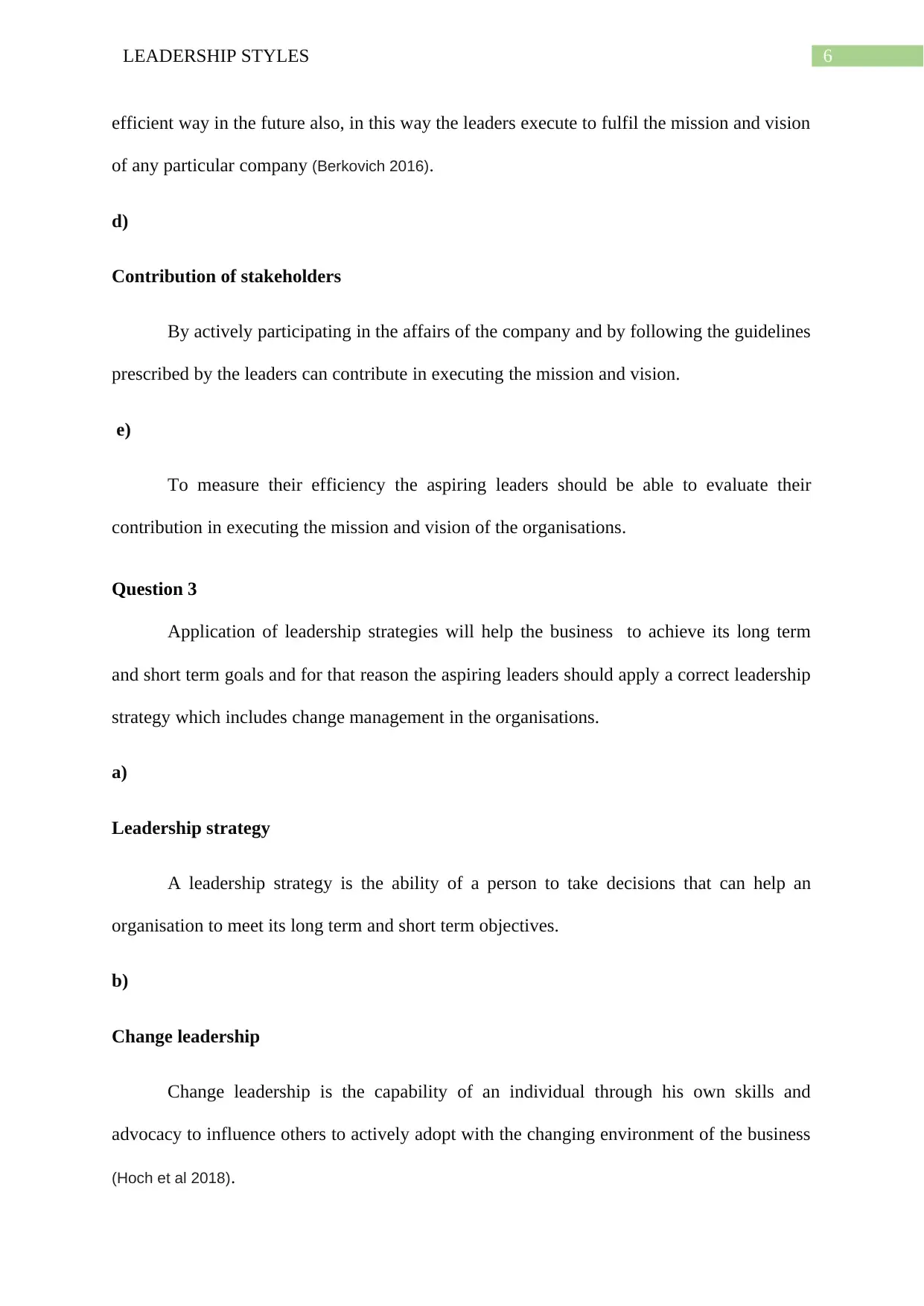
6LEADERSHIP STYLES
efficient way in the future also, in this way the leaders execute to fulfil the mission and vision
of any particular company (Berkovich 2016).
d)
Contribution of stakeholders
By actively participating in the affairs of the company and by following the guidelines
prescribed by the leaders can contribute in executing the mission and vision.
e)
To measure their efficiency the aspiring leaders should be able to evaluate their
contribution in executing the mission and vision of the organisations.
Question 3
Application of leadership strategies will help the business to achieve its long term
and short term goals and for that reason the aspiring leaders should apply a correct leadership
strategy which includes change management in the organisations.
a)
Leadership strategy
A leadership strategy is the ability of a person to take decisions that can help an
organisation to meet its long term and short term objectives.
b)
Change leadership
Change leadership is the capability of an individual through his own skills and
advocacy to influence others to actively adopt with the changing environment of the business
(Hoch et al 2018).
efficient way in the future also, in this way the leaders execute to fulfil the mission and vision
of any particular company (Berkovich 2016).
d)
Contribution of stakeholders
By actively participating in the affairs of the company and by following the guidelines
prescribed by the leaders can contribute in executing the mission and vision.
e)
To measure their efficiency the aspiring leaders should be able to evaluate their
contribution in executing the mission and vision of the organisations.
Question 3
Application of leadership strategies will help the business to achieve its long term
and short term goals and for that reason the aspiring leaders should apply a correct leadership
strategy which includes change management in the organisations.
a)
Leadership strategy
A leadership strategy is the ability of a person to take decisions that can help an
organisation to meet its long term and short term objectives.
b)
Change leadership
Change leadership is the capability of an individual through his own skills and
advocacy to influence others to actively adopt with the changing environment of the business
(Hoch et al 2018).
Paraphrase This Document
Need a fresh take? Get an instant paraphrase of this document with our AI Paraphraser
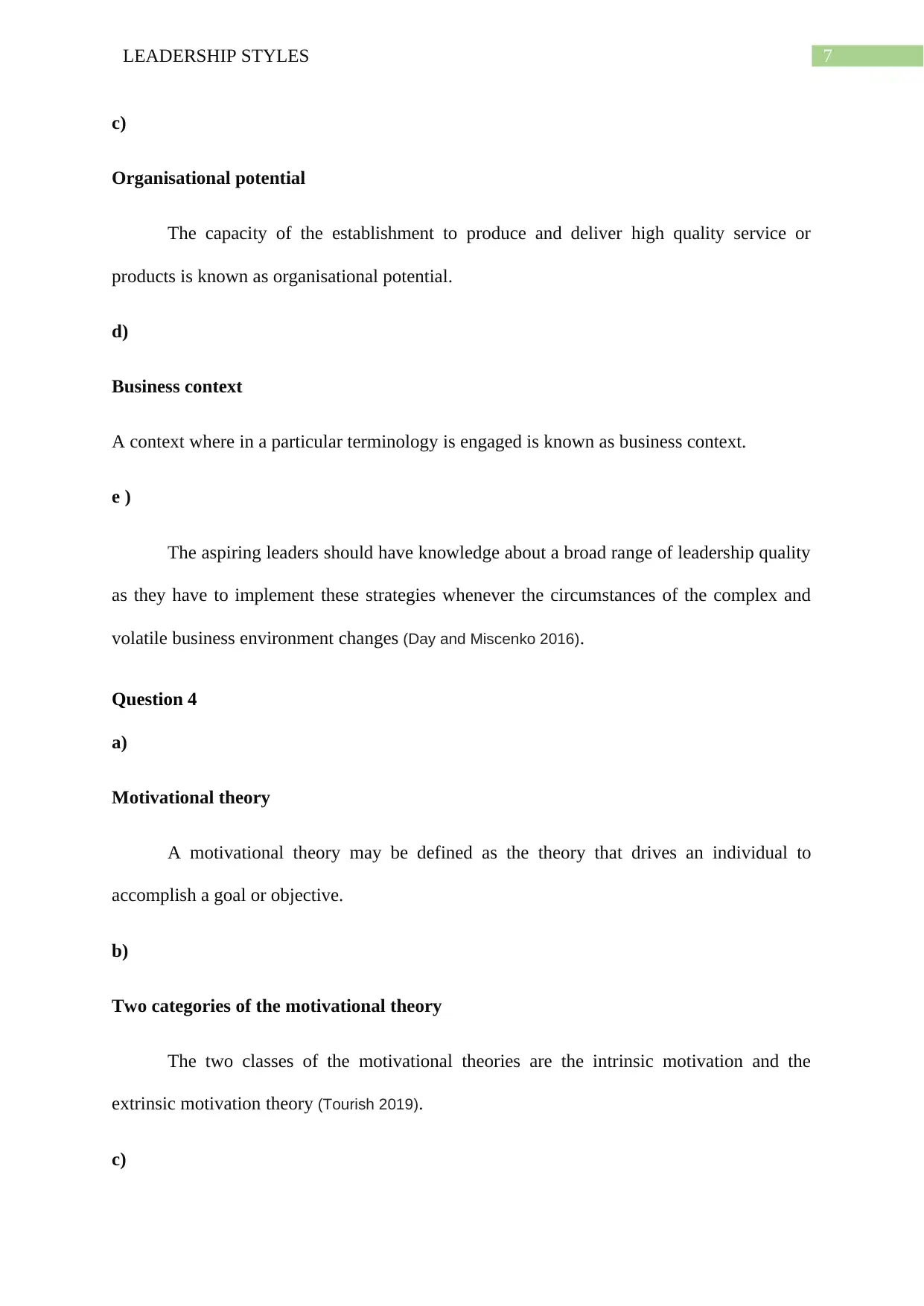
7LEADERSHIP STYLES
c)
Organisational potential
The capacity of the establishment to produce and deliver high quality service or
products is known as organisational potential.
d)
Business context
A context where in a particular terminology is engaged is known as business context.
e )
The aspiring leaders should have knowledge about a broad range of leadership quality
as they have to implement these strategies whenever the circumstances of the complex and
volatile business environment changes (Day and Miscenko 2016).
Question 4
a)
Motivational theory
A motivational theory may be defined as the theory that drives an individual to
accomplish a goal or objective.
b)
Two categories of the motivational theory
The two classes of the motivational theories are the intrinsic motivation and the
extrinsic motivation theory (Tourish 2019).
c)
c)
Organisational potential
The capacity of the establishment to produce and deliver high quality service or
products is known as organisational potential.
d)
Business context
A context where in a particular terminology is engaged is known as business context.
e )
The aspiring leaders should have knowledge about a broad range of leadership quality
as they have to implement these strategies whenever the circumstances of the complex and
volatile business environment changes (Day and Miscenko 2016).
Question 4
a)
Motivational theory
A motivational theory may be defined as the theory that drives an individual to
accomplish a goal or objective.
b)
Two categories of the motivational theory
The two classes of the motivational theories are the intrinsic motivation and the
extrinsic motivation theory (Tourish 2019).
c)
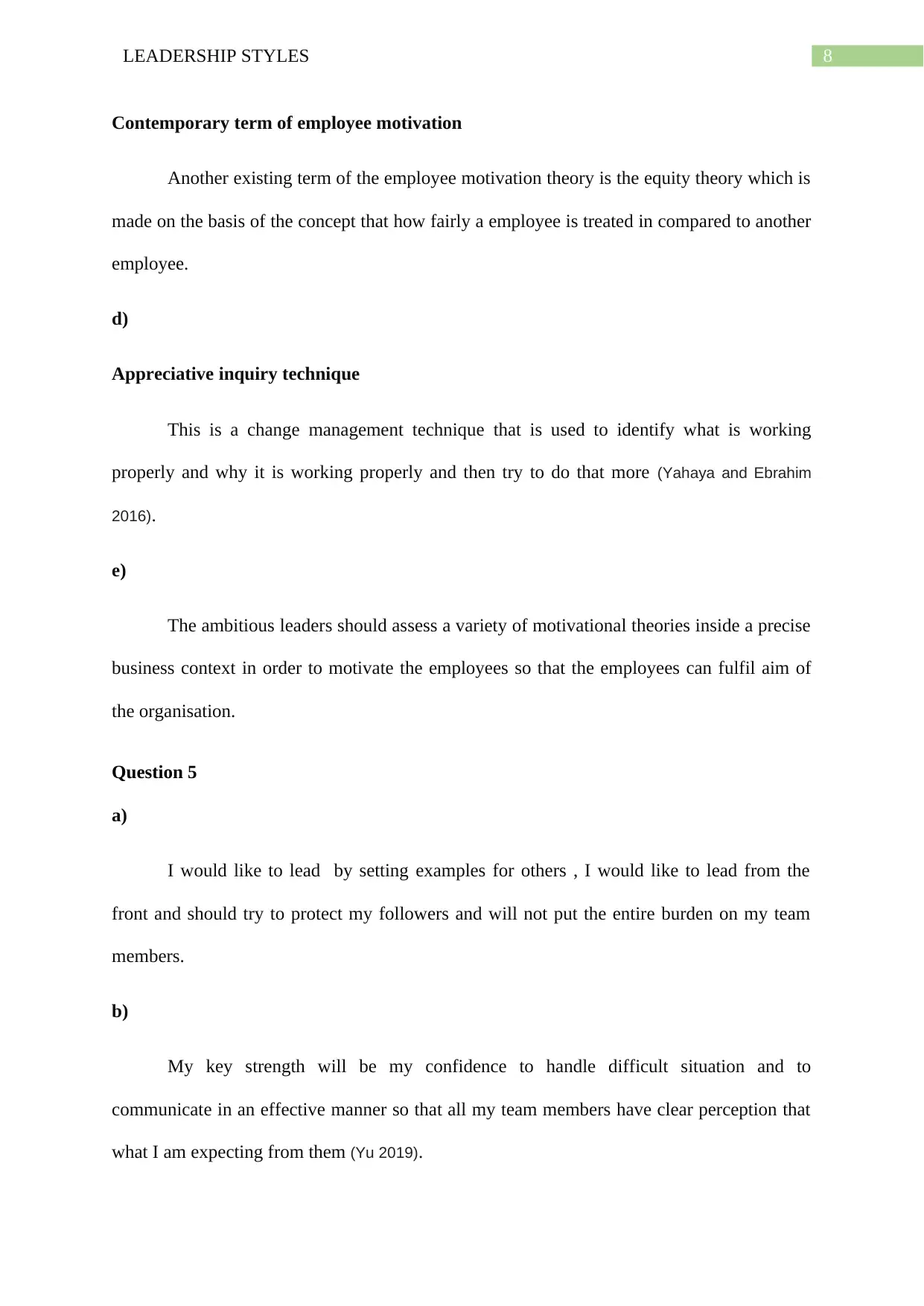
8LEADERSHIP STYLES
Contemporary term of employee motivation
Another existing term of the employee motivation theory is the equity theory which is
made on the basis of the concept that how fairly a employee is treated in compared to another
employee.
d)
Appreciative inquiry technique
This is a change management technique that is used to identify what is working
properly and why it is working properly and then try to do that more (Yahaya and Ebrahim
2016).
e)
The ambitious leaders should assess a variety of motivational theories inside a precise
business context in order to motivate the employees so that the employees can fulfil aim of
the organisation.
Question 5
a)
I would like to lead by setting examples for others , I would like to lead from the
front and should try to protect my followers and will not put the entire burden on my team
members.
b)
My key strength will be my confidence to handle difficult situation and to
communicate in an effective manner so that all my team members have clear perception that
what I am expecting from them (Yu 2019).
Contemporary term of employee motivation
Another existing term of the employee motivation theory is the equity theory which is
made on the basis of the concept that how fairly a employee is treated in compared to another
employee.
d)
Appreciative inquiry technique
This is a change management technique that is used to identify what is working
properly and why it is working properly and then try to do that more (Yahaya and Ebrahim
2016).
e)
The ambitious leaders should assess a variety of motivational theories inside a precise
business context in order to motivate the employees so that the employees can fulfil aim of
the organisation.
Question 5
a)
I would like to lead by setting examples for others , I would like to lead from the
front and should try to protect my followers and will not put the entire burden on my team
members.
b)
My key strength will be my confidence to handle difficult situation and to
communicate in an effective manner so that all my team members have clear perception that
what I am expecting from them (Yu 2019).
⊘ This is a preview!⊘
Do you want full access?
Subscribe today to unlock all pages.

Trusted by 1+ million students worldwide
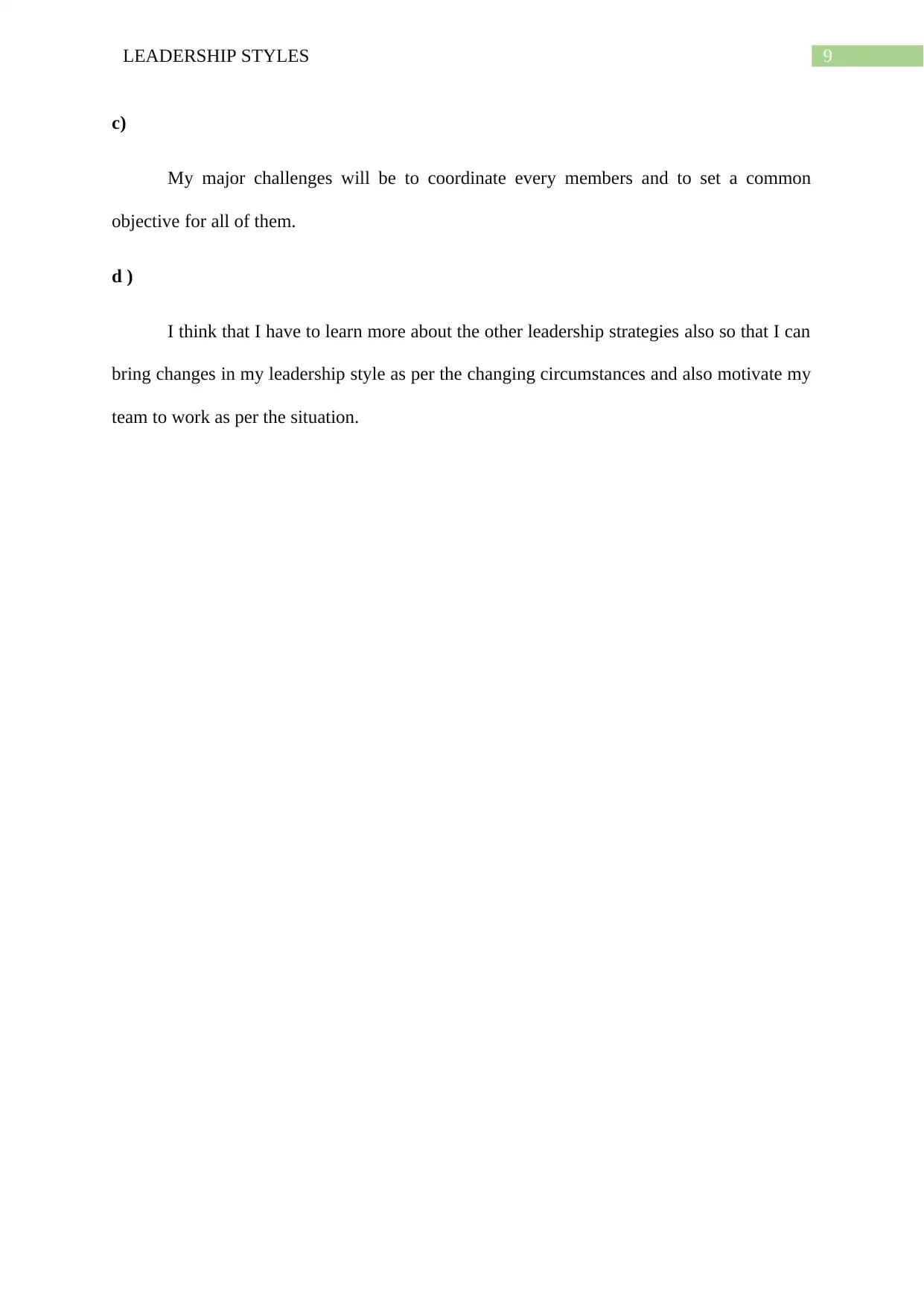
9LEADERSHIP STYLES
c)
My major challenges will be to coordinate every members and to set a common
objective for all of them.
d )
I think that I have to learn more about the other leadership strategies also so that I can
bring changes in my leadership style as per the changing circumstances and also motivate my
team to work as per the situation.
c)
My major challenges will be to coordinate every members and to set a common
objective for all of them.
d )
I think that I have to learn more about the other leadership strategies also so that I can
bring changes in my leadership style as per the changing circumstances and also motivate my
team to work as per the situation.
Paraphrase This Document
Need a fresh take? Get an instant paraphrase of this document with our AI Paraphraser
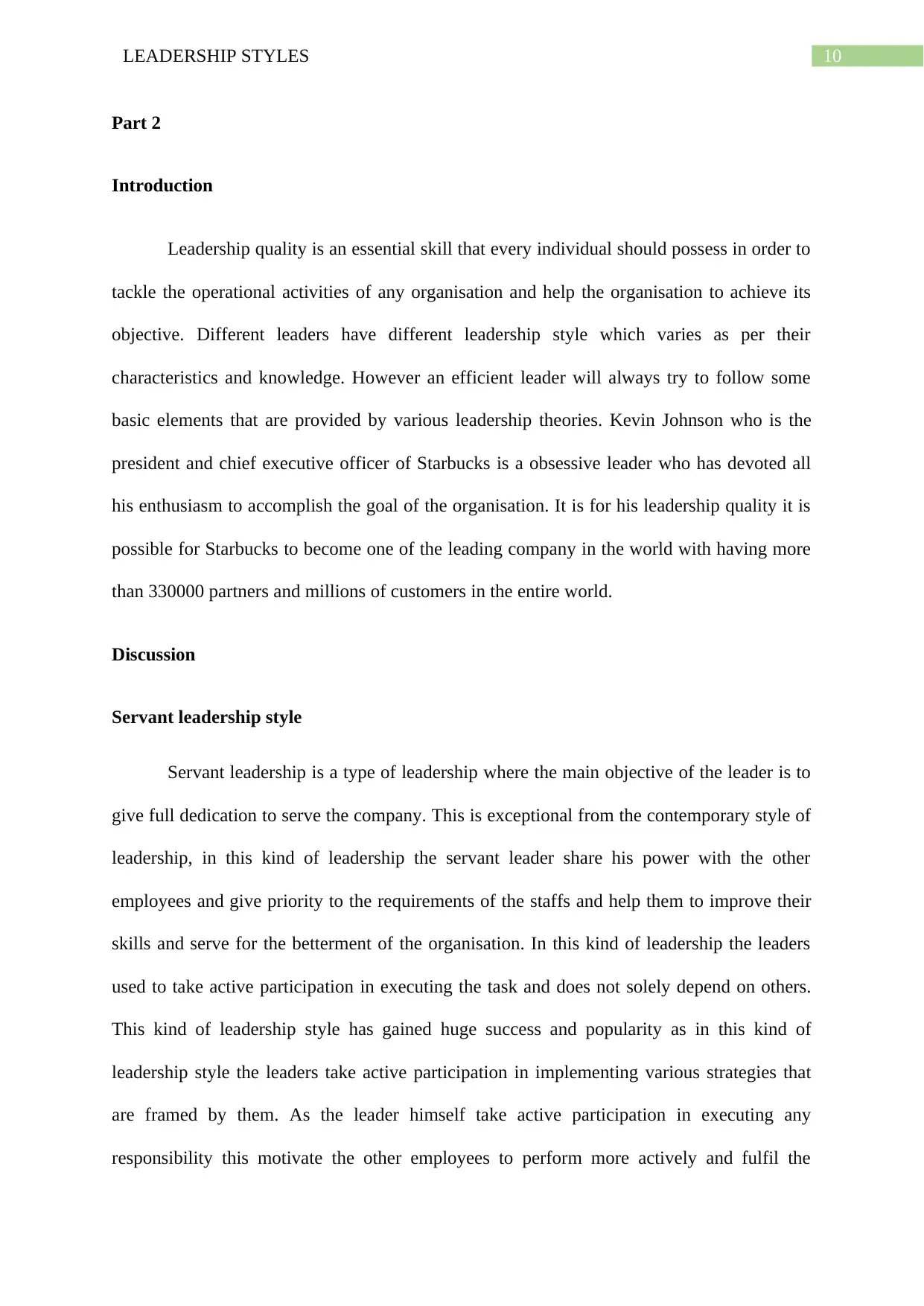
10LEADERSHIP STYLES
Part 2
Introduction
Leadership quality is an essential skill that every individual should possess in order to
tackle the operational activities of any organisation and help the organisation to achieve its
objective. Different leaders have different leadership style which varies as per their
characteristics and knowledge. However an efficient leader will always try to follow some
basic elements that are provided by various leadership theories. Kevin Johnson who is the
president and chief executive officer of Starbucks is a obsessive leader who has devoted all
his enthusiasm to accomplish the goal of the organisation. It is for his leadership quality it is
possible for Starbucks to become one of the leading company in the world with having more
than 330000 partners and millions of customers in the entire world.
Discussion
Servant leadership style
Servant leadership is a type of leadership where the main objective of the leader is to
give full dedication to serve the company. This is exceptional from the contemporary style of
leadership, in this kind of leadership the servant leader share his power with the other
employees and give priority to the requirements of the staffs and help them to improve their
skills and serve for the betterment of the organisation. In this kind of leadership the leaders
used to take active participation in executing the task and does not solely depend on others.
This kind of leadership style has gained huge success and popularity as in this kind of
leadership style the leaders take active participation in implementing various strategies that
are framed by them. As the leader himself take active participation in executing any
responsibility this motivate the other employees to perform more actively and fulfil the
Part 2
Introduction
Leadership quality is an essential skill that every individual should possess in order to
tackle the operational activities of any organisation and help the organisation to achieve its
objective. Different leaders have different leadership style which varies as per their
characteristics and knowledge. However an efficient leader will always try to follow some
basic elements that are provided by various leadership theories. Kevin Johnson who is the
president and chief executive officer of Starbucks is a obsessive leader who has devoted all
his enthusiasm to accomplish the goal of the organisation. It is for his leadership quality it is
possible for Starbucks to become one of the leading company in the world with having more
than 330000 partners and millions of customers in the entire world.
Discussion
Servant leadership style
Servant leadership is a type of leadership where the main objective of the leader is to
give full dedication to serve the company. This is exceptional from the contemporary style of
leadership, in this kind of leadership the servant leader share his power with the other
employees and give priority to the requirements of the staffs and help them to improve their
skills and serve for the betterment of the organisation. In this kind of leadership the leaders
used to take active participation in executing the task and does not solely depend on others.
This kind of leadership style has gained huge success and popularity as in this kind of
leadership style the leaders take active participation in implementing various strategies that
are framed by them. As the leader himself take active participation in executing any
responsibility this motivate the other employees to perform more actively and fulfil the
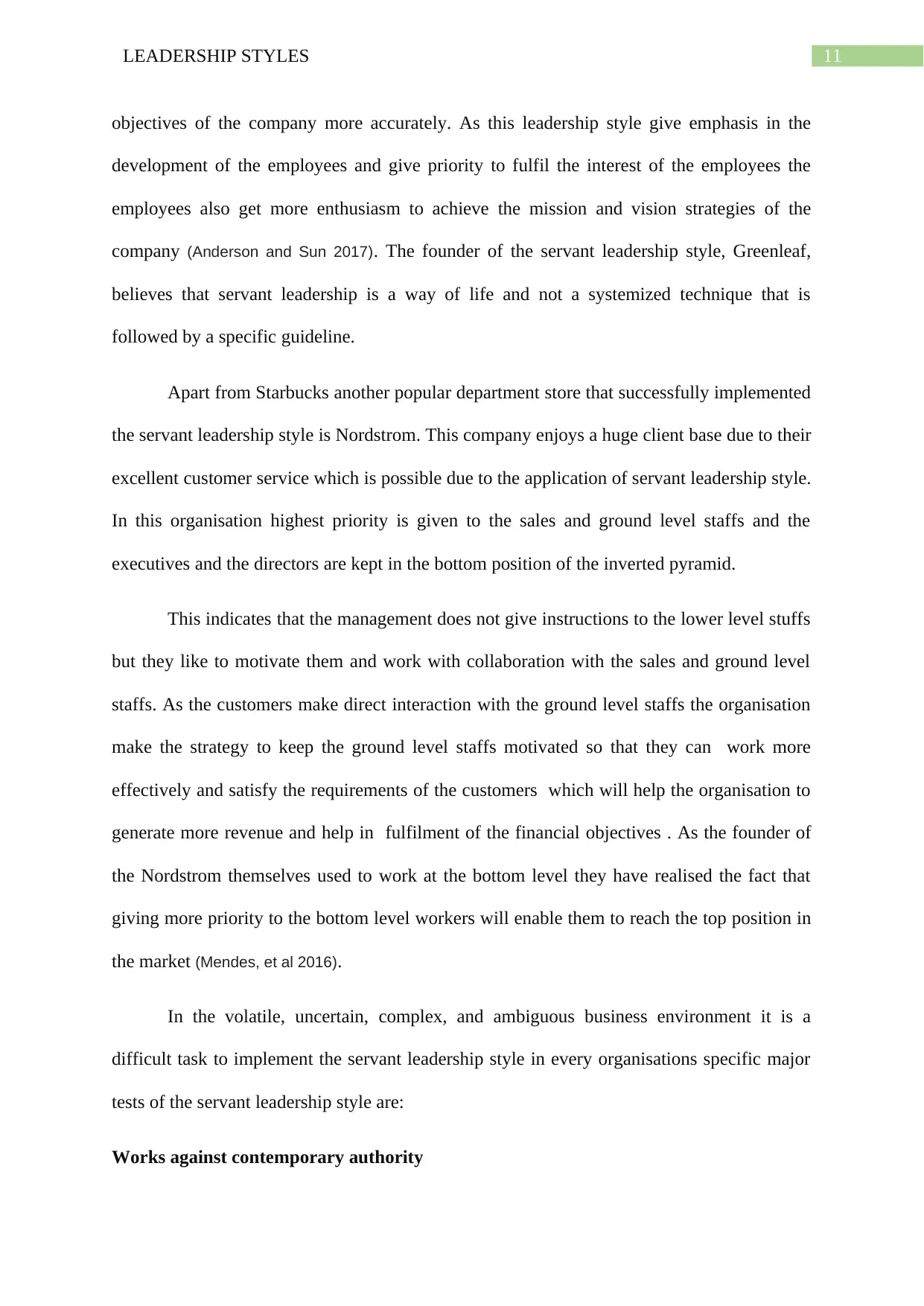
11LEADERSHIP STYLES
objectives of the company more accurately. As this leadership style give emphasis in the
development of the employees and give priority to fulfil the interest of the employees the
employees also get more enthusiasm to achieve the mission and vision strategies of the
company (Anderson and Sun 2017). The founder of the servant leadership style, Greenleaf,
believes that servant leadership is a way of life and not a systemized technique that is
followed by a specific guideline.
Apart from Starbucks another popular department store that successfully implemented
the servant leadership style is Nordstrom. This company enjoys a huge client base due to their
excellent customer service which is possible due to the application of servant leadership style.
In this organisation highest priority is given to the sales and ground level staffs and the
executives and the directors are kept in the bottom position of the inverted pyramid.
This indicates that the management does not give instructions to the lower level stuffs
but they like to motivate them and work with collaboration with the sales and ground level
staffs. As the customers make direct interaction with the ground level staffs the organisation
make the strategy to keep the ground level staffs motivated so that they can work more
effectively and satisfy the requirements of the customers which will help the organisation to
generate more revenue and help in fulfilment of the financial objectives . As the founder of
the Nordstrom themselves used to work at the bottom level they have realised the fact that
giving more priority to the bottom level workers will enable them to reach the top position in
the market (Mendes, et al 2016).
In the volatile, uncertain, complex, and ambiguous business environment it is a
difficult task to implement the servant leadership style in every organisations specific major
tests of the servant leadership style are:
Works against contemporary authority
objectives of the company more accurately. As this leadership style give emphasis in the
development of the employees and give priority to fulfil the interest of the employees the
employees also get more enthusiasm to achieve the mission and vision strategies of the
company (Anderson and Sun 2017). The founder of the servant leadership style, Greenleaf,
believes that servant leadership is a way of life and not a systemized technique that is
followed by a specific guideline.
Apart from Starbucks another popular department store that successfully implemented
the servant leadership style is Nordstrom. This company enjoys a huge client base due to their
excellent customer service which is possible due to the application of servant leadership style.
In this organisation highest priority is given to the sales and ground level staffs and the
executives and the directors are kept in the bottom position of the inverted pyramid.
This indicates that the management does not give instructions to the lower level stuffs
but they like to motivate them and work with collaboration with the sales and ground level
staffs. As the customers make direct interaction with the ground level staffs the organisation
make the strategy to keep the ground level staffs motivated so that they can work more
effectively and satisfy the requirements of the customers which will help the organisation to
generate more revenue and help in fulfilment of the financial objectives . As the founder of
the Nordstrom themselves used to work at the bottom level they have realised the fact that
giving more priority to the bottom level workers will enable them to reach the top position in
the market (Mendes, et al 2016).
In the volatile, uncertain, complex, and ambiguous business environment it is a
difficult task to implement the servant leadership style in every organisations specific major
tests of the servant leadership style are:
Works against contemporary authority
⊘ This is a preview!⊘
Do you want full access?
Subscribe today to unlock all pages.

Trusted by 1+ million students worldwide
1 out of 22
Related Documents
Your All-in-One AI-Powered Toolkit for Academic Success.
+13062052269
info@desklib.com
Available 24*7 on WhatsApp / Email
![[object Object]](/_next/static/media/star-bottom.7253800d.svg)
Unlock your academic potential
Copyright © 2020–2025 A2Z Services. All Rights Reserved. Developed and managed by ZUCOL.





